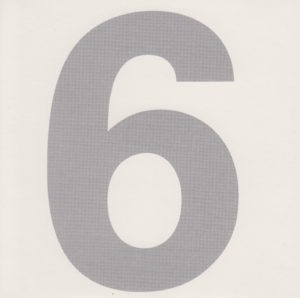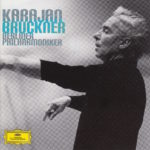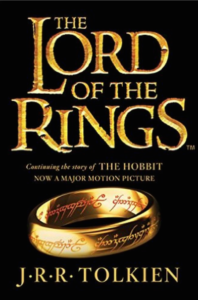 This morning’s conductor of Anton Bruckner’s Symphony No. 4 in E Flat Major (WAB 104), titled “Romantic” by Bruckner himself, is another heavy hitter in the world of conductors – Austrian Herbert Von Karajan (1908-1989).
This morning’s conductor of Anton Bruckner’s Symphony No. 4 in E Flat Major (WAB 104), titled “Romantic” by Bruckner himself, is another heavy hitter in the world of conductors – Austrian Herbert Von Karajan (1908-1989).
If Karajan was one of Tolkien’s rings in his The Lord of the Rings novels, he’d be the One to Rule Them All.
Karjan was that well known, that powerful.
Fortunately, he’s not one of Tolkien’s rings.
And I am not under his spell. I listen to each performance afresh, judge it on its merits, not on its star performer.
But, as director Marty DiBergi says at the start of the movie This Is Spinal Tap, “But, hey. Enough of my yakkin’. Whattaya say? Let’s boogie.”
So, boogie I will – with a cup of Eight O’clock Coffee on one side and a cat demanding to be fed on the other.
 I first encountered Maestro Karajan in my 144-day exploration on Day 8. Prior to that, it was Day 24. Most recently, on Day 40.
I first encountered Maestro Karajan in my 144-day exploration on Day 8. Prior to that, it was Day 24. Most recently, on Day 40.
Go back and review my reviews, if you must. Or just hang tight with this one until you read to the end. Then go back. Or don’t. It’s up to you.
Before I get too subjective about this morning’s recording, here are the nuts and bolts:
Bruckner’s Symphony No. 4 in E Flat Major composed in 1874
Herbert Von Karajan conducts
Karajan used the 1878/1880 version, edited by Robert Haas
Berliner Philharmoniker plays
The symphony clocks in 64:11
This was recorded in Berlin, Germany, in April of 1975
Karajan was 67 when he conducted it
Bruckner was 50 when he composed it
This recording was released on the Deutsche Grammophon Record Label
Of the 1878/1880 version, its entry on Wikipedia tells us this:
1880 version (aka 1878/1880)
After the lapse of almost a year (during which he composed his String Quintet in F Major), Bruckner took up his Fourth Symphony once again. Between 19 November 1879 and 5 June 1880 he composed a new finale – the third, though it shares much of its thematic material with the first version – and discarded the Volksfest finale. Thus the 1880 version is the same as the 1878 version but with a new finale. This was the version performed at the work’s premiere on 20 February 1881, which was the first premiere of a Bruckner symphony not to be conducted by Bruckner himself. This version is sometimes referred to as the 1878/80 version.
From the liner notes by Richard Osborne:
As with the Third Symphony, Brucker made several attempts on this work but the 1878 revision of the 1874 original satisfied him more or less completely. This was published in 1880 a nd is the version recorded here. Unhappily, many music publishers have long circulated a spurious edition of 1889 prepared by Franz Schalk and Ferdinand Lowe. The existence of this edition, and the symphony’s nickname “Romantic”, can only distract us from the recognizing in the first movement Bruckner at his most logical, commanding, and serene, writing with the confidence of a master now fully in charge of his brief.
Bruckner wrote his symphonies in four parts. The time breakdown of this one (Symphony No. 4 in E Flat Major, 1878/1880 version, ed. by Haas), from this particular conductor (Karajan) and this particular orchestra (Berliner Philharmoniker) is as follows:
I. Bewegt, nicht zu schnell (With motion, not too fast) (E-flat major)…………..18:14
II. Andante, quasi allegretto (C minor)…………………………………………………………..14:27
III. Scherzo. Bewegt (With motion) – Trio: Nicht zu schnell (Not too fast) (B-flat major)……………………………………………………………………………………………………………..10:43
IV. Finale: Bewegt, doch nicht zu schnell (With motion, but not too fast) (E-flat major)………………………………………………………………………………………………………………20.28
Total running time: 64:11
Okay. Now for the subjective stuff…
My Rating:
Recording quality: 5 (slight tape hiss, slight ambient sounds)
Overall musicianship: 5
CD liner notes: 5 (extensive liner notes, translated into English, German, and French, all with a distinctly Karajan-is-the-One-Ring feel to them)
How does this make me feel: 5
“Huzzah!”
Double “Huzzah!”
This performance makes me feel like I’m part of it, like I’m sitting near Maestro Karajan watching and feeling the emotion from the orchestra.
And there’s plenty of emotion here.
The recording engineers get two thumbs up for this one. Everything is mic’ed just right. The brass is not brassy. The violins are soothing. The French horns are mellow and alluring.
What especially attracted me this morning was the ending of the Finale, perhaps from 17:55 onward. I was captivated, hooking on every note. In fact, the whole of the Finale is grand.
Grand is one of the words I’d use for this performance. Ironically, too. For a symphony nicknamed “Romantic,” the word “grand” is probably not a fitting adjective. Yet, for all of the intimacy of Bruckner’s Fourth Symphony, it still has a grandness, a sweeping boldness that makes the quieter, more intimate parts even more so.
My quibble with this Karajan box set is in how DG labeled the CD sleeves and how they correspond to the symphonies. In this case, the CD 6 sleeve houses Symphony No. 4. Most all other box sets I own (I’d say 95% of them) make a point to have CD sleeve 4 house Symphony No. 4. It’s confusing the way DG did it.
 So. What have I learned from this morning’s listening?
So. What have I learned from this morning’s listening?
That Karajan is not Sauron.
That the difference a day makes is remarkable.
That Eight O’clock coffee rocks.
That my cat will not leave me alone until I feed him.
And that I’d better double check to make sure: Maybe Karajan is the One Ring.
Nah. Couldn’t be.
